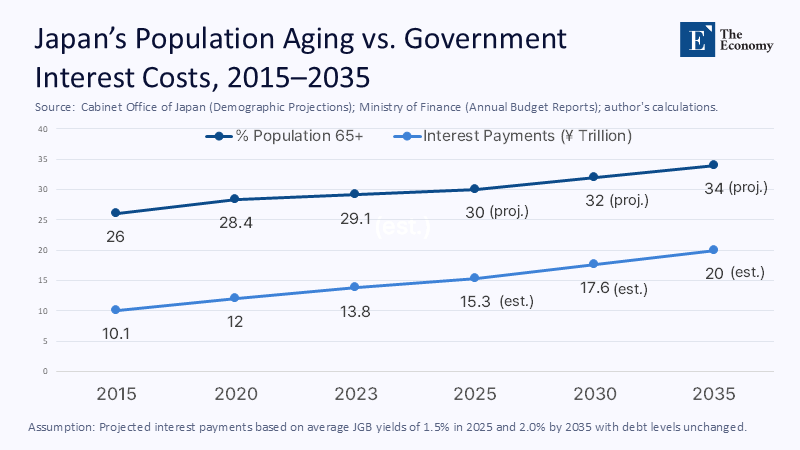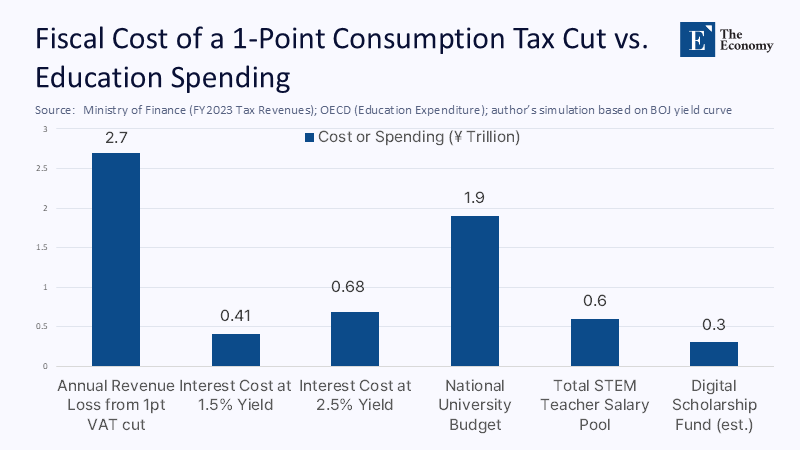Beyond Empty Streets and Full Ledgers: Japan's Debt-Demography Election
Input
Changed
This article was independently developed by The Economy editorial team and draws on original analysis published by East Asia Forum. The content has been substantially rewritten, expanded, and reframed for broader context and relevance. All views expressed are solely those of the author and do not represent the official position of East Asia Forum or its contributors.
Every seventy-five seconds, Japan loses a citizen to age or illness, whereas a birth occurs only once every forty-three seconds. The arithmetic is brutal: 1.62 million deaths versus 720,988 births in 2024 resulted in a demographic crater of 941,012 souls—roughly 2,460 fewer residents every day. Meanwhile, the public ledger shows ¥1,324 trillion in gross debt, equivalent to 234.9% of GDP, and the coupon on thirty-year bonds breached 3.14% after a weak auction last May. Each basis point added to that curve now subtracts approximately ¥132 billion per year from the potential for new classrooms, clinics, and labs. With the Jul 20 upper-house election days away, voters must decide whether to keep the unpopular ten-per-cent consumption tax—and safeguard the country's solvency—or embrace populist vows to slash it, risking a chain reaction of higher rates, capital repatriation, and still slower growth. Demography and debt are marching in lockstep toward an inflection point, a critical juncture where the consequences of inaction could be dire. Policy must learn to keep pace with them.

Demography and Debt: The Twin Sinkholes Requiring Urgent Action to Avert Catastrophe
Japan's fiscal deterioration did not begin with the present cabinet; its roots lie in the 1991 asset-price collapse, which curtailed nominal GDP just as the baby boom cohort was approaching retirement age. Citizens aged sixty-five and over already make up 29.1% of the population, and the Cabinet Office's medium variant projects a rise to 34% by 2035. Pension, healthcare, and long-term care entitlements now absorb 33% of the general account, up from 2% a decade ago. Because the formulas are indexed to beneficiary counts rather than discretionary ceilings, outlays expand automatically even when real growth is flat.

The bond market magnifies the demographic load. At the turn of the millennium, net interest accounted for 6% of central government spending; in FY 2024, the share rose to 10.1% despite policy rates hovering near zero, primarily due to volume effects. A return to average funding costs before Abenomics (roughly 2.2%) would increase the interest bill by approximately ¥21 trillion—three-quarters of the entire education budget, which accounts for only 4.0% of GDP. Local governments feel the pinch first: Shimane's per-student ICT budget is already 18% below 2015 levels (inflation-adjusted) after transfers from Tokyo shrank to cover coupon payments.

The market structure once cushioned Tokyo from rate shocks; domestic investors held nearly 90% of JGBs and tended to buy and hold. That insulation is fraying. Life insurers, facing peak benefit payouts early in the next decade, are shortening their duration, and the Bank of Japan is tapering its monthly purchases. More supply now lands on dealer balance sheets and eventually on foreign desks, which price risk against U.S. Treasuries, not on political goodwill. Debt is deepening precisely as demand grows elastic—a textbook recipe for price lurches.
Labour-force arithmetic tightens the vise. Even with record female participation and a modest rise in foreign workers, the active labor pool shrank by 620,000 in 2024, resulting in a decline in withholding tax receipts—the largest single source of revenue. Without offsets, the primary deficit is projected to rise from 2.5% to 3.4% of GDP by 2027. Immigration could slow the slide, yet net inflows last year were only 88,000. Productivity gains or genuine austerity are the remaining levers, and neither comes cheap.
Doing Right, Losing Votes: The Political Cost of Prudence
Fiscal rectitude rarely wins elections. An NHK poll published on Jul 7 put cabinet approval at 31%, while 52% of respondents backed opposition calls to slash or abolish the sales tax. Utility bills have risen after April's energy-price liberalization, making tax cuts electorally seductive and restraint politically perilous.
Moody's warned on Jul 4 that significant, durable tax cuts born of electoral brinkmanship could "materially weaken debt affordability" and threaten Japan's A1 rating. Markets fired a warning shot the next day when super-long yields spiked nine basis points before the BOJ staged an emergency purchase. That volatility illustrates how quickly sentiment can shift from calm to panic once credibility erodes.
Inside the ruling coalition, factions diverge. One bloc argues that limiting tax relief is the only prudent course; another fear that restraint could forfeit power—and hand fiscal levers to an opposition still more eager to borrow. This prisoner's logic, a situation where each party fears the other's actions, nudges policy toward the lowest-common-denominator outcome: a tax holiday large enough to court swing votes yet too small to revive growth.
Generational splits sharpen the dilemma. The University of Tokyo surveys find voters under thirty favor debt reduction by 12 points, while those over sixty—now the largest bloc—prefer stimulus by similar margins. Turnout tilts heavily toward seniors (72% versus 39% for twenty-somethings), skewing promises toward immediate gains even when they erode opportunities for younger citizens.
Cutting Taxes in a Bond Market on Edge
Quantitative diagnostics clarify the stakes. The consumption tax nets ¥27 trillion a year; a one-point cut removes ¥2.7 trillion. Funded at today's 1.5% ten-year yield, the first-round coupon cost is ¥40.5 billion; at 2.5%, a level already seen in portions of the curve, the burden jumps to ¥67.5 billion. A 200-basis-point parallel shift, mirroring the May move in super-longs, doubles the tally once floating-rate paper reprices.
Investor behavior is path-dependent. Option-implied volatility on ten-year JGB futures rose to 4.2 vol points after the opposition tabled its tax-cut bill, illustrating how quickly risk premia can emerge when consolidation appears to be abandoned. The macro feedback loop is unforgiving: higher sovereign yields widen corporate spreads, lifting hurdle rates for capital expenditures just when Japan hopes to scale advanced manufacturing and green technology. A Development Bank of Japan study finds that a 50-basis-point rise in the benchmark rate reduces private fixed investment by 0.7 percentage points over two years. Slower productivity growth then shrinks the tax base, pushing debt ratios still higher.
Projected forward to 2030, the numbers grow bleak. With nominal GDP growing at 1%, a two-point VAT cut would push the debt-to-GDP ratio above 255%. If growth underperforms by half a point—a plausible outcome of capital expenditure retrenchment—the ratio would breach 260% even before the impact of cyclical shocks.
The Carry-Trade Tripwire
Japan's ¥666.86 trillion stock of foreign portfolio assets—more than half in rate-sensitive bonds—rests on the yen carry trade: borrow cheaply at home, invest in higher-yielding currencies, hedge selectively, and pocket the spread. A decisive climb in domestic yields narrows that spread, enticing repatriation. The carry trade, a strategy where investors borrow in a low-interest-rate currency to invest in a higher-interest-rate currency, could be destabilized if domestic yields rise significantly, potentially leading to a foreign investment exodus.
Deutsche Bank simulations suggest a 150-basis-point rise across the curve could draw back 10% of life-insurer holdings—about $120 billion. Such flows would unwind dollar-yen carry positions, strengthening the currency, clipping exporters' margins, and feeding deflationary pressure. Simultaneously, U.S. Treasuries would sell off as Japanese investors exit, nudging global yields higher.
Currency dynamics amplify the hazard. Bond stress tends to lift the yen as carry trades unwind; however, a bleaker fiscal outlook can pull the currency lower through real-yield expectations. The tug-of-war breeds volatility: in May, the yen swung four yen per dollar within three sessions—the broadest range since 2022. JPMorgan's high-frequency models indicate that a daily two-sigma move in Japanese financial conditions is equivalent to a 15-basis-point policy hike, illustrating how a carry reversal can tighten domestic credit even before formal tightening occurs.
Beyond Austerity: Designing Credible, Voter-Acceptable Reform
Avoiding the debt-demography spiral need not condemn households to permanent belt-tightening. One option is to recycle a fixed share of VAT revenue into means-tested quarterly rebates modeled on Canada's GST credit. Households with an income below ¥4 million would receive electronic vouchers covering two VAT points; the tax remains in place, but the relief targets those under the most significant financial strain.
A second lever is spending quality. Overlapping subsidies in agriculture, SME finance, and regional public works consume roughly ¥6 trillion annually while delivering modest growth spillovers. Diverting even half into outcome-based education grants could hire 15,000 new STEM teachers and fund 200,000 digital upskilling scholarships—investments with measurable returns in lifetime earnings and, by extension, future taxes.
Credibility rests on rules. Embedding a debt brake in the Public Finance Act—capping the structural deficit at 0.5% of GDP and mandating offsets for any giveaways—would hard-wire prudence. The brake would tighten automatically if the old-age dependency ratio overshoots the Cabinet Office's path, internalizing demographic trends in fiscal settings.
Transparency can raise the political bar. A quarterly "carry-stress index" in the BOJ's Financial System Report would quantify the sensitivity of overseas asset flows to domestic yield shocks, letting voters judge the second-round impacts of campaign pledges. A biannual "citizen's balance sheet" that shows how every ¥10,000 tax rebate costs ¥14,600 in extra interest over a decade could shift opinion more effectively than any technocratic op-ed.
Choose Tomorrow's Stability
Tax holidays soothe, but only for a season; debt and demographics endure. July's ballot, therefore, is a referendum on time preference. Unfunded VAT cuts spark a surge in spending yet set off a chain reaction—higher yields, carry unwinds, and currency whiplash—that ultimately lands back on taxpayers with compound interest. Maintaining the 10% rate, trimming low-impact subsidies, and hard-wiring a demographic-sensitive debt brake may feel onerous today, but they leave space for genuine growth through human capital investment. Japan's streets may be emptier, but its future need not be. Choosing fiscal prudence over quick populism is the surest way to pass on opportunity rather than IOUs.
The original article was authored by Richard Katz, a Special Correspondent for Weekly Toyo Keizai. The English version, titled "Ishiba cries wolf on government debt as election gambit," was published by East Asia Forum.
References
Deutsche Bank. (2025, May). Japan Rates Strategy Weekly.
JPMorgan. (2025, May). Japan FX Volatility and Financial Conditions Tracker.
Moody's Investors Service. (2025, Jul 4). Credit Implications of Japan's Upper-House Election
NHK/Reuters. (2025, Jul 7). Support for Japan PM Slides Further as Election Approaches
OECD. (2024). Education at a Glance 2024: Japan Country Note
Reuters. (2024, Feb 27). Japan's Births Fall to Record Low in 2024
Reuters. (2024, Aug 7). Explainer: What Is the Yen Carry Trade?
Reuters. (2025, May 20). Japan's Super-Long Bond Yields Soar to Records
Reuters. (2024, May 30). Japan to Keep Record Wealth Overseas
Statistics Bureau of Japan. (2023, Oct 1). Current Population Estimates





















